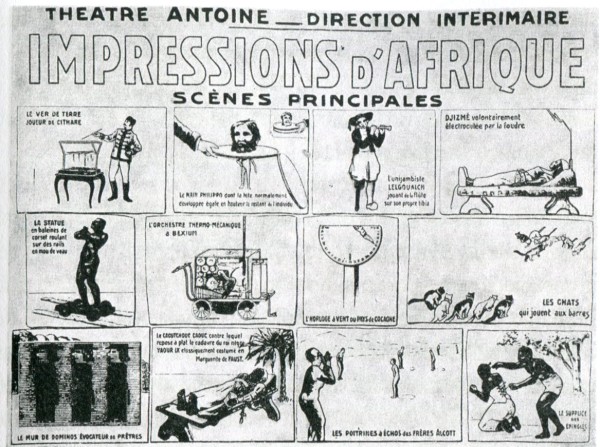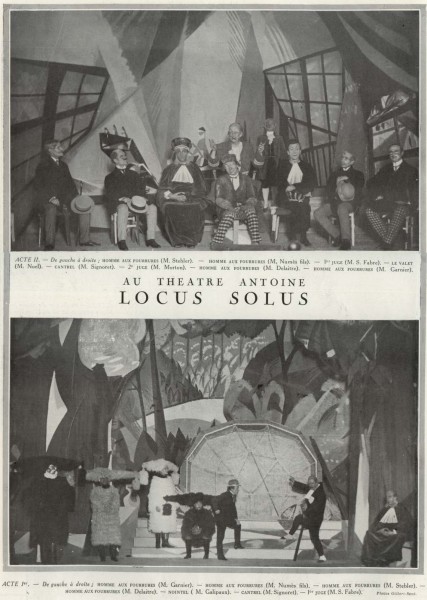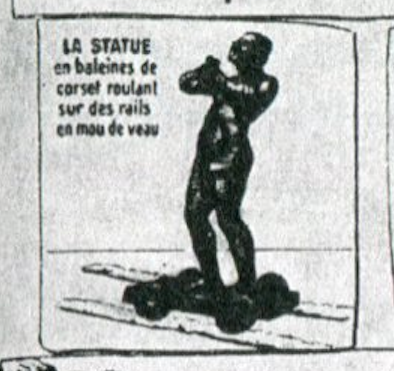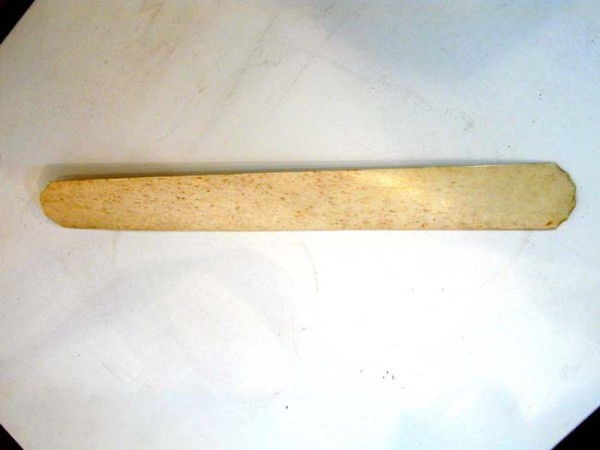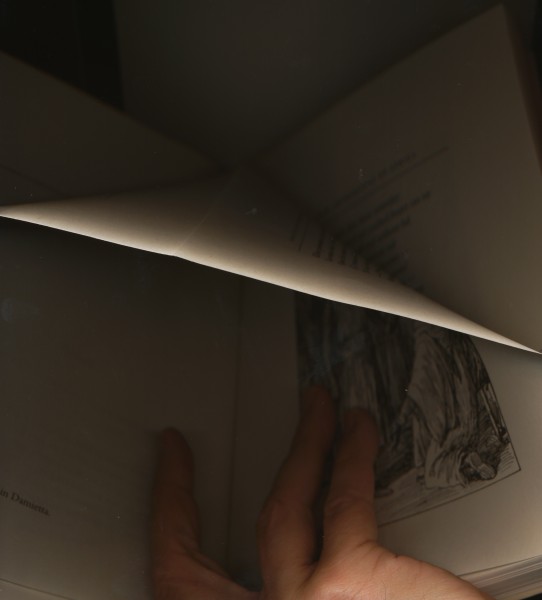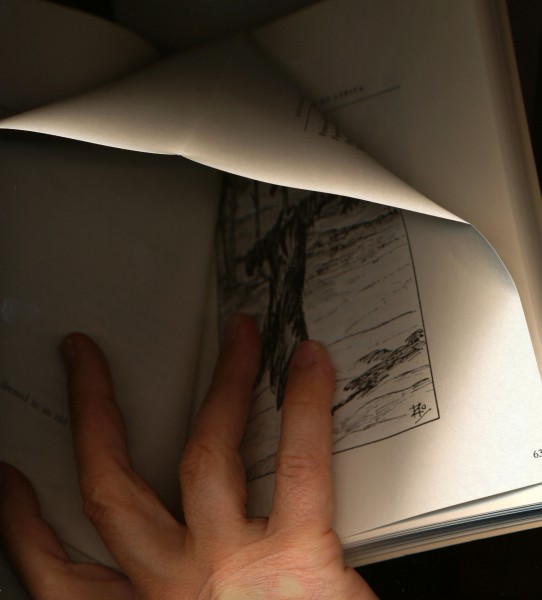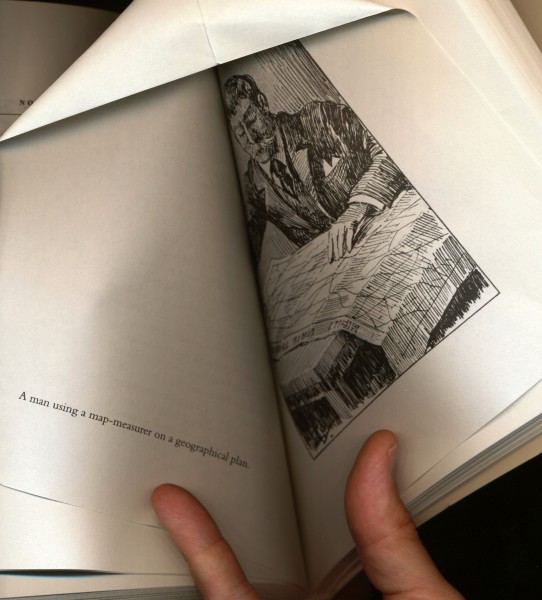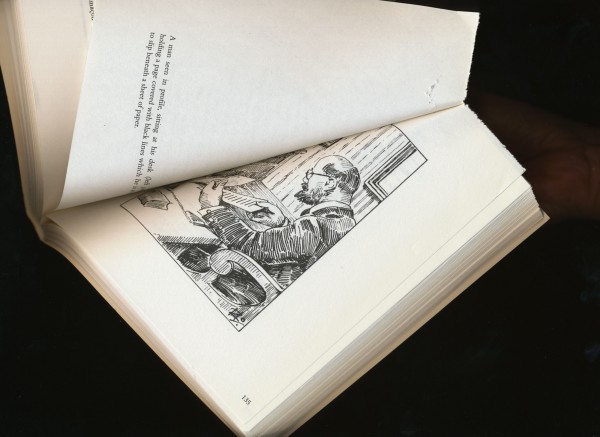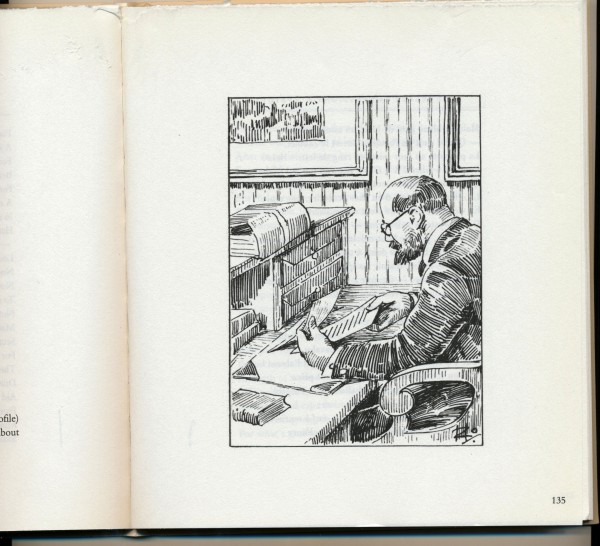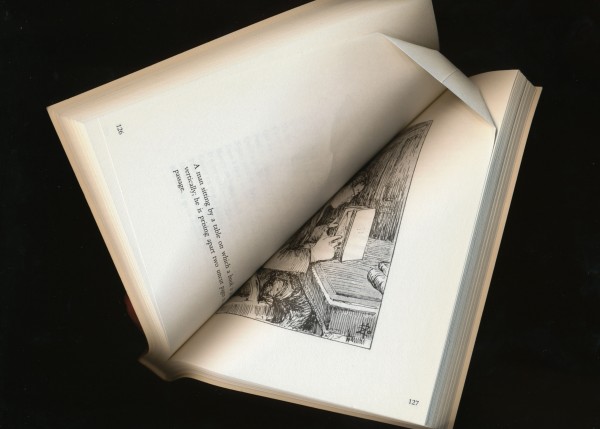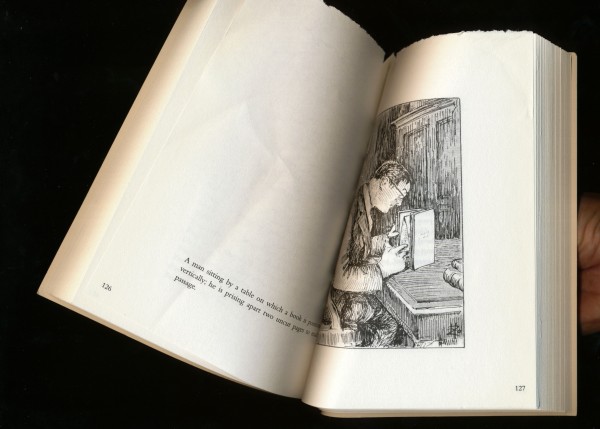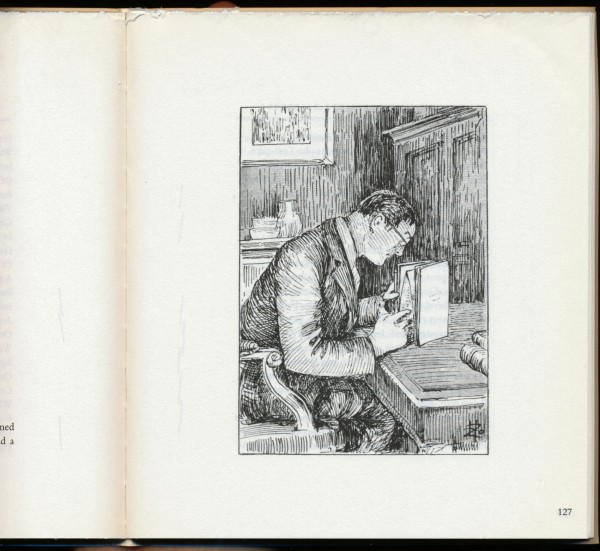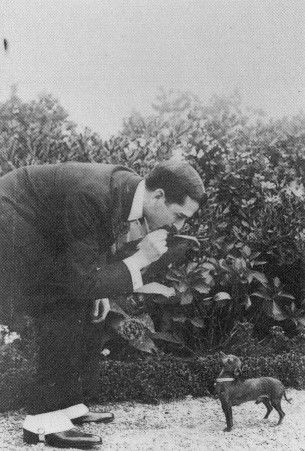To ask about illustrations in this book—which is arguably one of the two or three principal modernist sources for books written with images—it is first necessary to ask: What does it entail, physically and sequentially, to read this book? And to ask that question, it’s necessary to step back, I think, not only to the secondary literature including Deleuze and Foucault, but to Roussel’s earlier, and simpler, Impressions of Africa.
Reading “Impressions of Africa”
This book is unillustrated, although Roussel produced a theatrical version of it, and also of the book Locus Solus.
Both books are a kind of hypertrophy of ekphrasis, so I want to return briefly to the discussion of ekphrasis in chapter 2. One of the first oddities the book presents, in astonishing detail, is a statue made of “corset whalebones,” resting on a “very simple conveyance,” which in turn rests on rails made of “calves’ marrow” (p. 10, English translation of 1983). The statue and its rails appear in the theater poster:
The English translation, by Lindy Foord and Rayner Heppenstall, is wrong here: “mou de veau” are poumon, lungs or “lights.” The rails, Roussel informs us, were made of “some coarse, reddish, gelatinous substance,” which turns out to be veal lights. (The “whalebone corsets” are actually “busks.” A whalebone corset or stay busk is shown below.)
This passage is the ekphrasis, which would normally stand alone in a text, or be augmented by a narrative context. (As in the classic example, the ekphrasis of Achilles’s shield in the Iliad, which occurs as part of the larger narrative and is explained by that context.) In Impressions of Africa we are instead given further ekphrases, and then many pages later an explanation in the form of yet another ekphrasis. In this case the “explanation” involves a magpie who has been trained to fly up to the statue and “thrust its beak” into “two openings, scarcely perceptible, more than a yard apart,” cut into the pedestal of the statue. (The pedestal is not shown on the theater illustration: the rails rested on it. I wonder if Roussel omitted the entire performance with the magpie because it would have involved training a bird. I wonder, too, if he used some of his wealth to fabricate a statue out of actual whalebone corset busks in the manner the text describes: that would have been possible, but expensive.) The mechanism that the magpie triggers makes the entire statue, with its “very simple conveyance,” tilt back and forth on its rails, without “flattening or breaking” them (p. 26). That, apparently, is the explanation of the initial ekphrasis and the point of the performance, which the African king watched “with wonder.”
This second ekphrasis, which may seem more of a mystery than the first, is finally supplemented, very late in the book, by a third narrative and ekphrasis. That last one tells the story of the person who made the statue, and gives the reason for the demonstration—to show how resiliently he could cook calves’ lights—and the theme of the statue, which turns out to be a grammatical test given to a Lacedaemonian helot (slave) named Saridakis, who was compelled to conjugate a Greek verb. When he failed he was stabbed (p. 296).
These three ekphrases together are an absolute ruin of sense: a reader might expect an explanation after the first ekphrasis, but the second one only makes the visual image more complex; and the third passage explains the first two only in the sense that it fills in the iconography and some background information, such as the source of the corset busks. This malfunction of ekphrasis is pertinent to what happens in New Impressions of Africa, and it is an example of the kind of maltreatment of language that fascinated both Deleuze and Foucault. Deleuze’s essay “He Stuttered” (translated in Gilles Deleuze and the Theater of Philosophy) is concerned with the state of “perpetual disequilibrium” that Roussel imposes on language. The idea that Roussel forces language to ruin itself in these ways is a more precise description of what happens in New Impressions of Africa than Foucault’s broader sense of Roussel’s practice of revealing “vacancies” and “voids” in language (Death and the Labyrinth). Roussel does exploit properties of language (punning, homonyms, slant rhymes, respellings, ambiguities of denotation) but what matters in relation to ekphrasis is the artificiality of it, the work it entails, the concerted effort a reader is compelled to expend both in visualizing and in deferring the desire for normative sorts of explanations.
Reading “New Impressions of Africa”
Here is Mark Ford’s very sober appreciation of the mechanics of reading New Impressions of Africa:
But then what can it possibly mean to read a book that keeps opening parentheses (like this ((and then parentheses within those, like this (((or this))) apparently endlessly (((and not at all always rationally ((((or so it seems)))) )))) )) ), playing arcane word games, making unconsciously ridiculous similes, proposing utterly opaque allusions, suggesting the reader pause to cut the intentionally uncut octavo pages, and posing book-length puzzles that can never be solved because they aren’t even (proper) puzzles. Even that sentence is easiest to read by plowing straight through. If I try to read it according to the order of the parentheses, I need to parse it carefully, and that is at once tedious and unrewarding.
Here, to begin, are the two obvious ways that New Impressions of Africa proposes that it be read:
1. Read by “plowing straight through,” including footnotes whenever they appear. This first kind of reading cannot yield the sense of any of the book’s cantos, because the logic, the argument — whatever it should be called — will be impossible to follow. The book will disintegrate into a series of images, often in couplets, often dissociated from one another.
2. Read the way the surrealist’s machine for turning the pages of the book supposedly worked: i.e., read to the opening of the first parentheses, find the place where that parenthesis closes, read from there to the end of the canto, return to the opening of the parenthesis, read (skipping interpolated parentheses), etc. — until you have read the very last quintuple-nested parenthesis.
The second sort of reading raises two further possibilities:
2a. Read mechanically, assiduously, skipping nothing, but reading in the moment, taking in each new stanza or couplet or page as it presents itself, rather than trying to keep the entire narrative and its parenthetical asides in mind at once.
2b. Read as you would read a piece of argumentative non-fiction, or a detective story: that is, try to keep the entire argument, logic, stories, and grammar in mind as you go.
I think this last is the real challenge of the book, although I see little evidence that critics have tried it. I think the logic and structure of the book itself makes such a reading just barely possible, and therefore necessary.
I have read Canto 2, ‘The Battlefield of the Pyramids,’ in this way, keeping the logic of the entire canto in mind as I read. It opens with three nested arguments in the space of half a page: a description of a coat (then a parenthesis opens, and inside it begins a description of a scarecrow, as an allegory of faith ((then a double parenthesis opens, and inside it a meditation on the cross apparently begins)) ); the first two arguments end where the parentheses close, on the last page of the canto. It was possible for me, one afternoon, to keep the entire top-heavy, preposterously artificial, tottering, twisted, perverse, demanding narrative in mind at once. At that moment — which is now long gone — I felt I had expended the effort Roussel demanded, and found my way to a rigorous grasp of the text. A useless rigor, of course, but I also imagined that was part of the point. As in the iterated unexplained ekphrases of Impressions of Africa, the iterated annoying parentheses of New Impressions of Africa only repeat their promise not to explain anything in the end.
The illustrations
It is known that Roussel hired a private detective agency to hire his illustrator, in order to avoid direct contact with the artist; and it’s often mentioned that the pictures were mainly intended to illustrate passages in the text, and that some are about the book’s physical shape and the acts of reading. Roussel had the book printed in octavo, with uncut pages—something common in the 19th century but rare after books began to be automatically cut before they were sold. (Technically, the pages in Roussel’s book are “unopened,” not “uncut,” but the difference isn’t pertinent ((and neither is the fact that Roussel arranged things so that his book only has bolts (((folded pages in octavo))) that are uncut at the top, while older books had bolts uncut at the top, bottom, and fore-edge)): it doesn’t matter, I think, that this book is a demonstration or echo or allusion to actual uncut octavo books. I have read books that were fully uncut, and it becomes routine to cut each new page with a letter opener or a playing card. Roussel’s book is only intended as an allusion to all that.)
Here, in the Atlas bilingual edition, is one of the illustrations that seem to be self-referential. When you first encounter a plate in “New Impressions,” you have to peer in at it. It isn’t especially easy to see what some of the pictures are:
Some of the illustrations seem to have to do with what you, as a reader, are doing. Here is one that seems to depict a man reading:
The line on the left identifies him as a “map-measurer,” which seems even more appropriate as a description of a reader of New Impressions of Africa.
Even closer to the experience of peering at these images is this illustration, which shows a man “holding a page covered with black lines”:
Scholars have especially noted the following image, which shows a person trying to peer at images in an uncut octavo book, exactly as in New Impressions:
Once this page is cut, and the image can be clearly seen, it appears the illustrator didn’t actually try looking at images in uncut books, or didn’t depict the activity well, because the fold in the page is at the top—to see the half-hidden image, this reader would have turned the book to look at it from its fore-edge, or from slightly below, as I did in the first of these three photographs.
This general, and sometimes explicit, self-reference would seem to make the images different in kind from the text. It suggests that the images comment on the text, and are therefore different from it. In obvious ways, they are: they were commissioned to illustrate the text, and they were interpolated near the passages they illustrate. In a less obvious way, those differences signify a distance between text and image that is itself not easy to understand but consistently present. Images are, I think, exceptionally difficult in this book. This difficulty becomes apparent in at least five ways:
1. The mismatch between the regularly spaced images and the convoluted text. The images occur regularly throughout the poem, but the text is as uneven, in terms of reading order, as a text can be. Images occur approximately once per page, on average, and there are pages where they seem to have been chosen to be exactly equidistant from one another. (If there is evidence about the rules Roussel set himself in this regard, I haven’t found them, and it is possible that the placement of images was not rule bound—see the last point in this list that that possibility.) The sentences in the poem, on the other hand, are wildly tangled in terms of reading order and logic, and absurdly complicated in terms of structure. (For example, there are several passages in which Roussel launches into series of images that he thinks of as linked, and there is no way to know when, or if, they might end. The cantos of the book, and the verse structure, are misleading indications that the poem is comprised of parts that are commensurate in length.) The images therefore appear as a kind of ornament, one that is unattached to the structure that they decorate. Why did Roussel not think of producing monstrous, iterated, disproportionately arranged, unpredictably complex illustrations? Why choose the simplest commercial style of illustration? Why arrange the illustrations in such a linear way? I am not sure what kind of answer one might ever have gotten to questions like these, but the effect is that the images live in a different world, and it is not obvious why or how they do so.
2. The mismatch between the unrepresentable ideas in the poem and the prosaic subjects of the images. Most images are straightforward depictions of verbal images, similes, metaphors, allegories, puns, homonymic and metonymic associations, and other tropes in the poem. It stands to reason that Roussel chose images that could be easily illustrated. Illustrations of that kind can be taken as evidence that most of the poem cannot be pictured: it is verbal, linguistic, and non-pictorial. There is generally a wide distance between what can be pictured and what the poem is doing, and that distance is thrown into relief by Roussel’s choice of prosaic, easily drawn subjects. An example is the picture of the one on p. 131 of the Atlas Press edition. It depicts a small house covered in snow. The caption (which was also the instructions to the illustrator) reads:
A snow-covered cottage whose roof is shaped like a book laid spine upwards. No characters.
The corresponding couplet in the poem is one of a long series of things that Roussel says can be confused:
—for a roof’s fine snow-covered slopes
on some cottage, a book covered for school
Laid spine upwards;—
Note that even in cases like this, the pictures only illustrate the contents of the poem, not its sense. It isn’t possible to mistake the snow-covered roof in the illustration for a book. Roussel’s instructions made that very unlikely, since he only says the roof “is shaped like a book.” The illustrations are stubbornly literal, in stupid juxtaposition with the text, which is wildly imaginative (in the etymological sense of that word).
Other plates do not even illustrate the book’s images, or do so incompletely. The well-known image of the reader peering between two uncut pages has this for a caption:
A man sitting by a table on which a book is positioned vertically; he is prising apart two uncut pages to read a passage.
But the couplet this “illustrates” is also part of the list of things Roussel says can be confused:
—mothers without call
Opening a crib’s white drapes, for two uncut
Pages when prised apart;—
Note that in this case, the image only illustrates half the comparison, so it does not capture the thought. No one would look at this picture and think of the curtains of a crib.
The same is true of the image of the man “holding a page covered with black lines which he is about to slip under a sheet of paper,” which I reproduced above. (This scene is intended to show something many contemporary readers won’t have experienced: the scribe, or letter-writer, is using a simple ruled sheet to guide his handwriting; the paper he is writing on is translucent, and the lines will show through.) The passage in the poem this “illustrates” reads:
—for the un-complex
Aid of black lines, a stripy pattern sample
From a shirt-maker;— [p. 133]
(That’s another image most people won’t know: it refers to patterns bespoke shirt-makers used to use, which customers would have seen when they were measured. It’s interesting how some of the things in Roussel require descriptions that end up sounding like his prose.) But the point here is that again the visual similarity Roussel posits is not in the picture, and apparently wasn’t intended to be. So what, exactly, is the relation between images that capture entire couplets, or the sense of the relevant passage in the poem, and those that only capture fragments of the poem, or parts of tropes? Or, to put this as a matter of authorial intent: what sense of imagery did Roussel have that permitted him to overlook this kind of difference?
On the other hand, some illustrations function in quite normative ways. The first illustration in the book, which is the first one I reproduced above, has the caption “Saint Louis in prison in Damietta.” It comes just after the opening of the entire “New Impressions.” Canto I is called “Damietta,” and subtitled “THE HOUSE WHERE LOUIS IX WAS HELD PRISONER.” (p. 17) When that page is cut, it works as an entirely conventional illustration, and even as a slightly displaced frontispiece. It’s as if Roussel started that way, and then changed his mind about what was possible.
The opening of Canto II, “The Battlefield of the Pyramids,” is illustrated (on the following page) with a picture of a scarecrow. (It’s the second picture from his book that I reproduce here.) But the scarecrow does not illustrate the “Battlefield of the Pyramids”; it illustrates a completely different idea, which is inside the first nested parenthesis of the Canto: Roussel’s subject has shifted to things that people misconstrue, and the third example in his list is scarecrows, which are misconstrued as… but before he can say what, another parenthesis opens, and the reader doesn’t get to find out what until 112 pages later in the Atlas edition, when the Canto ends. (And even then, the comparison is difficult to understand. At root, Roussel is saying people construe the simple form of a scarecrow as a cross, and that leads him off on a long passage about the image of the cross. But when the Canto ends, it appears he is also saying birds stupidly construe the scarecrow as a man. It’s a double, asymmetrical, extended analogy, suspended for 112 pages.)
My point here is that Roussel chose to illustrate not the Canto’s title, as he did in the opening Canto, but an especially obscure, irrelevant, and difficult image, which is only partly present on the page preceding the illustration. The picture, as it were, remains oblivious of this outrageous complexity. If you pause to consider this image, you are distracted even from the distractions that the Canto has already presented. Images like this are like invisible parentheses inside the existing parentheses. In this way images veer back and forth from simple but inadequate illustrations, including conventional frontispiece-style emblems, and obscurely chosen images of unrepresentable tropes or ideas—and there is no logic to that oscillation.
3. Images and affect. Both the first and second points here fit well with the reception of Roussel, because they augment Deleuze’s and Foucault’s analyses of the ways Roussel works to show the void behind language, its illness, it inability to represent the world, its hollowness, its “perpetual disequilibrium.” An elaborated version of the first two points could supplement either of their accounts with evidence that Roussel also staged the breakdown of epistemology, representation, and sense in images. But I wonder if there might not be another reading available.
Especially in the final canto, the images settle into a mood, a tone, that compels attention apart from, and I think in intentional contrast to, the narrative. Canto IV is titled “The Gardens of Rosetta Seen from a Dahabia.” (A dahabia is a boat. The 2014 English Wikipedia gives a deliciously Roussellian definition: “A dahabeah, also spelled dahabeeyah, dahabiah, dahabiya, dahabiyah and dhahabiyya, as well as dahabiyeh and dahabieh… is a passenger boat used on the River Nile in Egypt.”) The narrative opens with a scene on the Nile, but two pairs of nested parentheses almost immediately hijack it, and turn the theme to a man who leaves a salon abruptly. The triple parentheses that comprise most of the canto are about words that change meanings, things that remain the same, and other lists that are familiar from previous cantos.
But the images are remarkable. They are:
(1) A night scene, with a starry sky, just before the canto opens. There follows (2) the man who leaves the salon abruptly; this is as close to a frontispiece, or emblem, of the canto as it could be. Then come three isolated figures or empty scenes, with violence, suspense, and death as recurring themes: (3) a mountain wilderness, (4) a man with a gun to his head, and (5) a man dropping a stone into a well and listening for its fall. This series is interrupted by (4) an anomalous head of Amerigo Vespucci. It continues with (5) a man shooting a gun, (6) an empty park bench, (7) a mountaineer alone on a mountain, hand to his ear listening, (8) a man ringing a doorbell. This increasingly fraught series of implicitly violent scenes is again interrupted by (9) the Biblical writing on the Wall from the Book of Daniel; and then the canto, and the entire poem, ends with (10) “a stretch of starry sky without any landscape, apparently seen from a point in outer space and giving an impression of the infinite.”
If a reader correlates these with the text, she will be drawn back into the grammatical games and nested parentheses. But by themselves, these images—despite, or perhaps because, they are drawn in such an uninterested, professional style—are affecting, and propose their own narrative.
Compression and expansion
These three themes are just the beginning of what should be a longer analysis. A picture, in New Impressions of Africa, is like a morpheme: it is linked to larger and more complex meanings, which work together to create what sense the poem has. In that full context, the illustrations are like morphemes in that their monadic meaning disappears—whatever could be said about them seems to be stifled by the tiny contexts into which they are compressed, or swallowed by the enormous complexity of the poetic machinery. As such they have an agonistic relation to the text that has no parallel, as far as I know, with other examples of writing with images.
By comparison with this, Sebald’s uses of images are pedestrian and illustrative. (But only in comparison: they raise other issues.) If other illustrated books used images in ways as complex as Roussel has in this book, the genre would be much more interesting.

